Introduction
Occasionally HTC takes a little break from high-end smartphones and dips its toes in the waters of the lower midrange. The HTC Wildfire is a down-sized, down-clocked and down-priced version of the HTC Desire. If Sony Ericsson can do it with the X10 mini, then HTC have all the right in the world to make a Desire mini too.


But while the Desire was something that easily snatched everybody’s attention, the Wildfire is a bit more toned down despite its fire-some name.
Key features
* Quad-band GSM/GPRS/EDGE support
* 3G with 7.2 Mbps HSDPA
* Android OS v2.1 (Éclair) with Sense UI
* 3.2" capacitive touchscreen of QVGA resolution
* Multi-touch support
* Qualcomm MSM 7225 528 MHz CPU, 384 MB RAM, 512 MB ROM
* 5 megapixel auto-focus camera with LED flash and touch focus
* Wi-Fi 802.11 b/g and GPS receiver
* Accelerometer sensor for auto-rotate
* Turn-to-mute, lift-to-tone-down
* Proximity sensor
* Smart dialing
* Standard miniUSB port for charging and data
* Bluetooth with A2DP, file transfers
* microSD card slot, a 2GB card in the box
* Standard 3.5mm audio jack
* Social network integration: Facebook, Twitter and Flickr through Friend Stream
* Flash-enabled browser
* Direct access to the official Android repository
* Stereo FM radio with RDS
Main disadvantages
* Poor screen image quality, QVGA doesn’t do Android OS and the display size justice
* No video-call camera or videocalling whatsoever
* CIF@15fps video recording (352 x 288 pixels) is below par
* No voice dialing
* No DivX or XviD video support out of the box
* No TV-out port
The Wildfire is certainly the right phone for those who like to always stay in touch. The high-end connectivity is all there, along with solid social network integration and browsing. It seems the display and CPU are the only downgrades from the Desire.
But that’s still a lot. Android phones with QVGA screens have failed to impress and the size of the Wildfire’s display gives no reason to be optimistic here.


On the other hand, the Wildfire boasts the premium finish of the Nexus One and the HTC Desire. Not only is a touch of style always welcome in the lower tiers of the market but users will probably appreciate the compact size too.
So, repackaging a flagship device to sell to a wider range of customers is easier said than done, so let’s see what the Wildfire has to offer. By the way, choosing a name that’s so much catchier is a good way to start.
We’re back after the break with a spin and a closer look at the HTC Wildfire exterior.
Retail package: good enough
Considering the lower price range, the HTC Wildfire’s package is fairly complete. It has the essentials and a couple of small perks: a 2GB microSD and a one-piece headset with music controls. The headset uses the a standard 3.5 mm audio jack so you can use your own instead, but you will have to live without the remote.
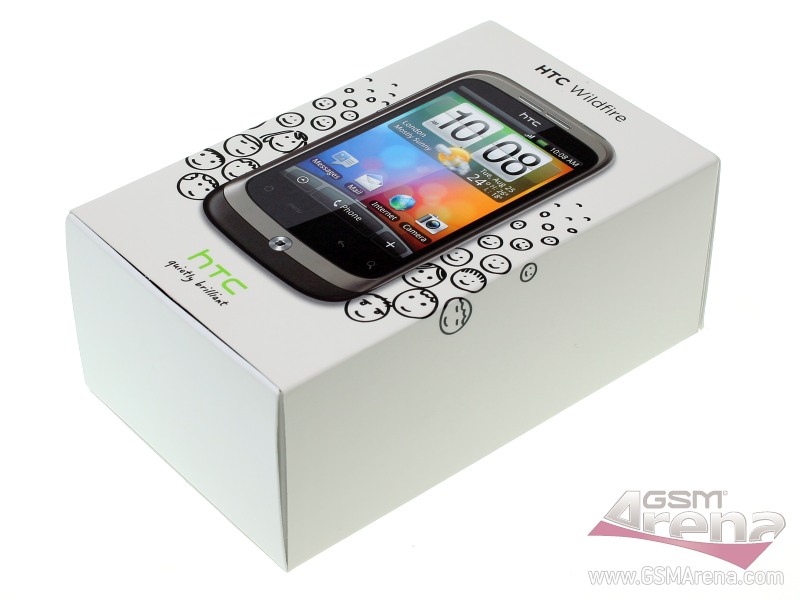
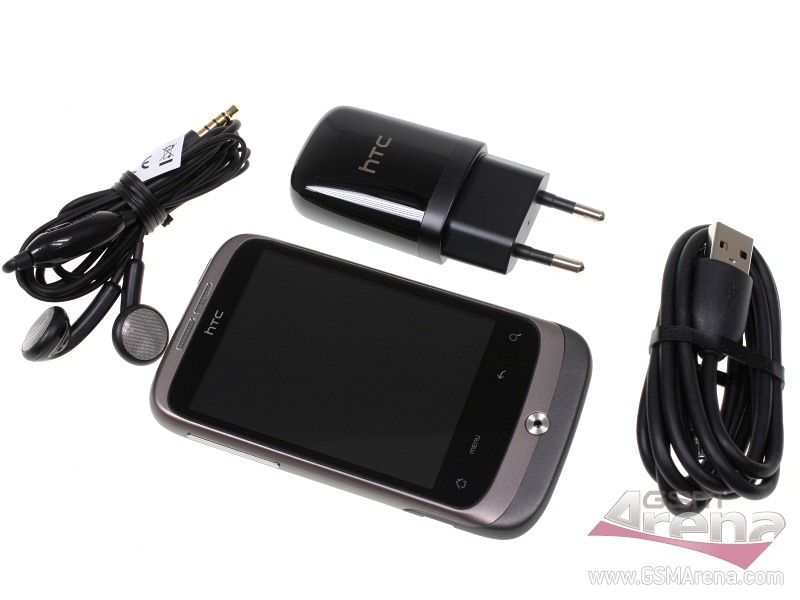
The microUSB cable plugs into the charger so you will need both to charge your HTC Wildfire the old fashioned way. USB charging is enabled too. A bunch of manuals complete the list of items in the box.
HTC Wildfire 360-degree spin
Keeping it compact was high on the Wildfire designers’ priority list. At 106.8 x 60.4 x 12 mm the device can easily slip in any pocket – let alone a purse. The phone certainly hopes to appeal to both male and female customers, and has the color range to do it. The Wildfire will be available in white, black, brown and red.


And while some may frown at the relatively heavy weight of 118 grams, we actually think it’s a benefit. The nice solid feel we’ve come to expect from high-end phones brings the Wildfire another step closer to the HTC Desire.
Design and construction
So, the Wildfire is a pretty close replica of the Desire (and the Nexus One). It doesn’t have the kind of looks to make your heart skip a beat, but it’s a subtly stylish and solidly built phone – and that’s nothing to be ashamed of.
Ok, it’s a phone that will grow up wearing its older brother’s old clothes. But we don’t have to worry about its self esteem. The designers were after decent functionality in an attractive looking package and we think they’ve done a pretty good job. The only thing to be concerned with is the screen. WVGA AMOLED was a treat in the Desire, but sadly the Wildfire is nowhere near that.
At 3.2” and QVGA resolution, the HTC Wildfire touchscreen offers the lowest pixel density we have seen lately and that’s a real disadvantage for the picture quality. 125 ppi is pretty good for a computer screen but you look at it from a much greater distance. The Wildfire you are meant to hold in your hands.
The contrast levels of the LCD unit are also quite underwhelming and we’re particularly disappointed with the depth of blacks on the Wildfire screen. The brightness levels are good but they are not enough of a boost for the overall poor picture quality.
And the Wildfire isn’t any better when exposed to direct sunlight either. You will struggle to find a proper angle for working with the phone when outside on a bright sunny day.
In general, the screen is where most of the cost-cutting has been done on the Wildfire. This doesn’t seem like a particularly smart move. The fact is, on a full-touch device the screen is almost all you look at and use. Having such a relatively large yet low-res screen creates a rather negative effect for the whole user experience.
On a positive note, the sensitivity of the capacitive touchscreen is excellent, plus 3.2” is more than enough space to press on. But still, a smaller display to make the low resolution less prominent might have made more sense, and the device would’ve been even more compact too. We just can’t see the point of making such a big QVGA screen. Neither Android nor HTC Sense looks good on it.
Below the display we find four capacitive controls. They are in charge of bringing you back to the homescreen, opening the context menu, taking you a step back in the menu navigation and getting you to the quick search box.
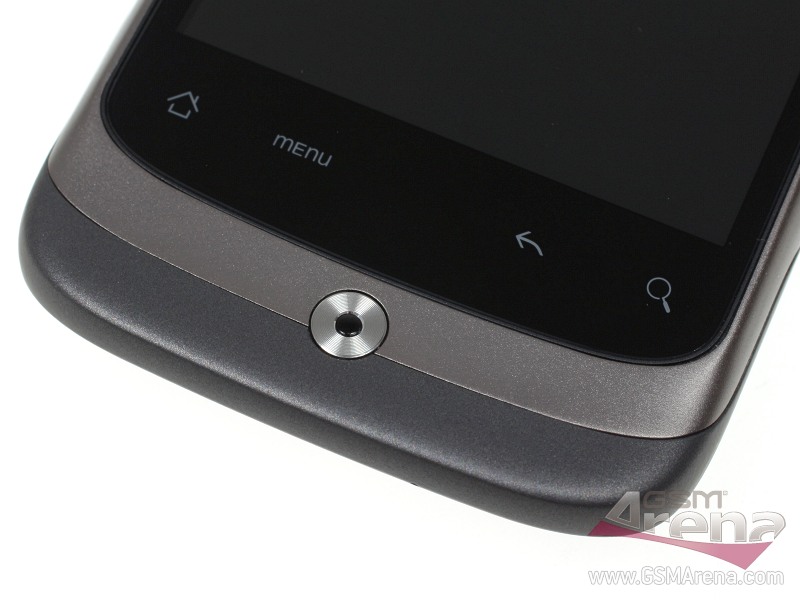
Sufficiently spaced and sensitive enough, those cause no usability problems whatsoever. The transition between them and the screen is seamless.
Under those four keys we find the optical joystick, which by the way is of pretty limited use. It will work in some menus to replace sweep gestures and can be used to take the occasional photo but that’s about it. Most users would probably never notice even if it didn’t work at all,– you can get by just fine without it.
Above the display we see the earpiece, the proximity sensor and the status LED.
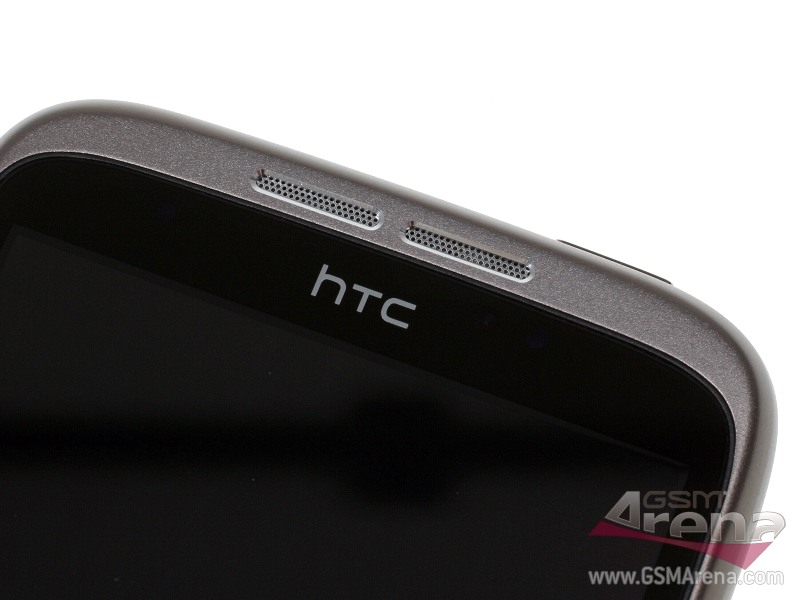
The left side of the Wildfire features the large volume rocker and the exposed microUSB port. The right side of the device is completely bare. A dedicated camera key would have certainly been nice.
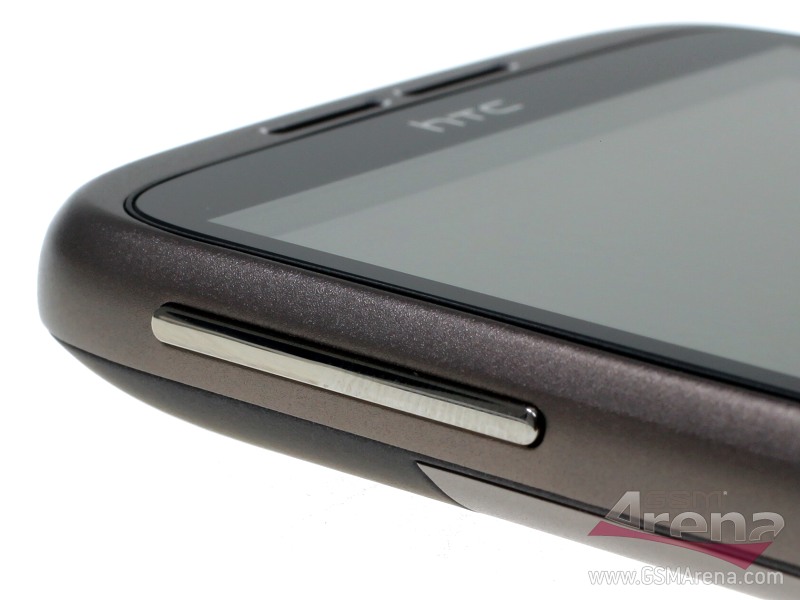
At the top there are a couple of elements to note. The silver key in the right corner is the power/screen lock button, the 3.5mm audio jack is at the other end.
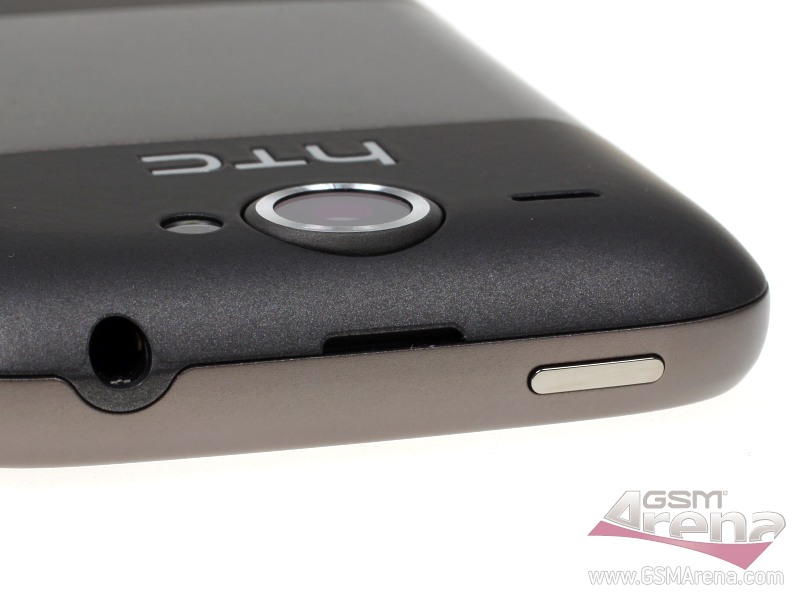
The tiny mouthpiece is the only thing of interest at the bottom.
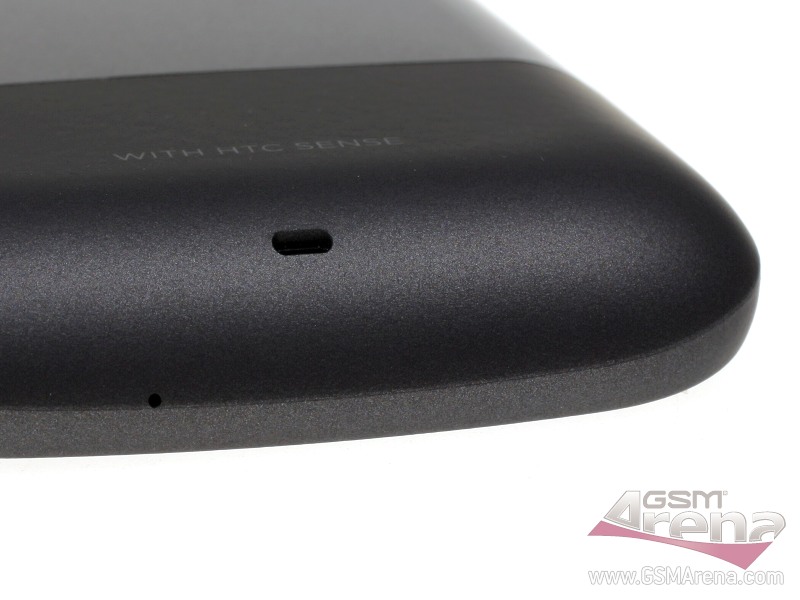
The 5 megaxpixel camera lens is near the top of the back cover, flanked by the loudspeaker grill and the LED flash. The lanyard also attaches at the back, near the bottom of the phone. You do need to remove the cover to attach it though.
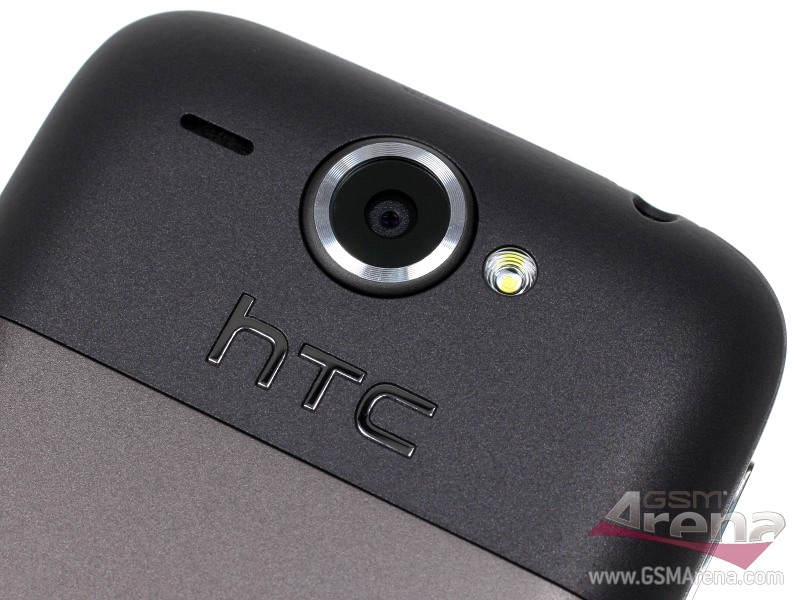
Under the cover you will find the microSD card slot and the 1300 mAh battery. The Li-Ion unit is quoted at up to 480 hours of stand-by or 7 hours and 20 minutes of talk time in 2G networks, and 690 hours and 8 hours in 3G mode.
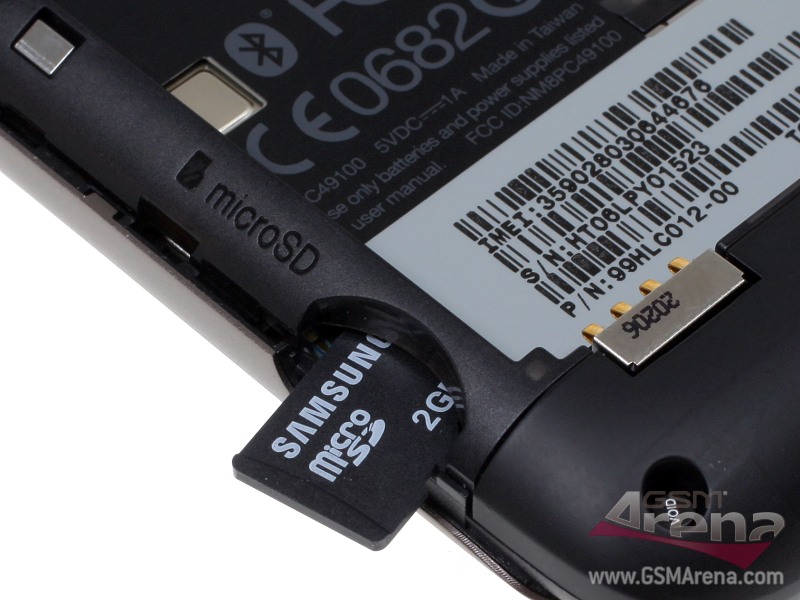
Those are some impressive numbers indeed but here’s one case perhaps where the low-res screen does count in its favor. The Wildfire did last for about three days of moderate use (10 minutes of calls and just under an hour of using the other features a day), which is still good but not that great.
The HTC Wildfire feels nice in the hand. Its size is just perfect for single-handed use and the screen sensitivity is a point in favor too. It’s ultimately the same screen though that puts the whole package in question. Users coming from touchscreen feature phones will probably not notice anything wrong. But upgraders from the Magic or the Tattoo might be disappointed.
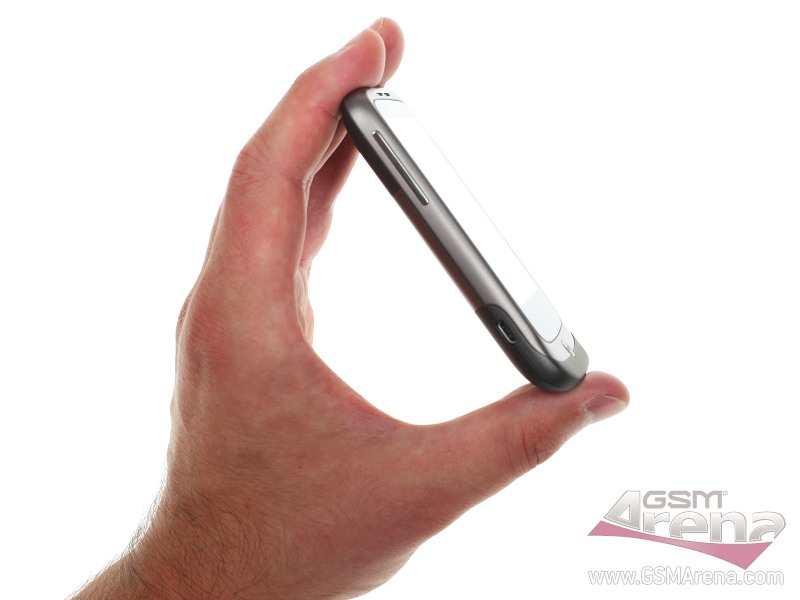
We have no arguments with the build quality and the finish. The Wildfire is a solid looking and stylish phone that will suit conservative tastes. There’s a selection of paintjobs too for those looking for something more expressive.
Now let’s go through the software side of things.
Eclair and HTC Sense deserve a higher-res screen
HTC Sense and Android have had a god run so far. From the Hero to the Desire, users have been treated to a wealth of graphics and features. Even the entry-level HTC Tattoo has the company’s custom interface, which we found to blend well and do a good job. It just didn’t look its best on the QVGA screen.
If you’ve been paying attention, you’d know the HTC Wildfire is having the same problem. And this time, the same number of pixels is stretched over 3.2 inches.
The Wildfire still has a clear advantage over the Tattoo. The capacitive display has excellent response. You’ll find the latest Sense UI too on the HTC Wildfire.
The main differences between this version of the Sense UI and back on the Tattoo are the new context icons, a few new wallpapers and the unified Widget section. Whether you are using the People, Mail, Music or Gallery Tabs, the scrollable icons at the bottom will please you with new color skins. We like it this way – the old ones looked a bit dull against the otherwise graphically rich and colorful UI..

The left key at the bottom of the screen launches the main menu. This time around you simply tap to get to it, you can't drag the menu out, though you can drag it back in.
The middle key is a shortcut to the Phone app and the right key brings up the "Add to Home" menu. And there's plenty to add to the homescreen but more on that later.
The scrollbar at the bottom is just an indication of which homescreen you’re on - it can't be used for actual scrolling. HTC have extended the homescreen to a total of seven panes instead of the usual three. With all those widgets at hand (which are quite useful too) they may not even be enough.
The HTC Sense UI revolves around Scenes, which are essentially six custom homescreen setups (Work, Travel, Social, etc). Each scene changes the wallpaper and the widgets on the homescreen - for instance, the Work scene has a stocks widget, while the Social offers a Twitter widget.
You can't modify the scenes but if you rearrange the current homescreen you are prompted to save changes as a new scene.
The Clean slate scene lets you start from scratch - it's just the default Android setup with a Clock and a few shortcuts underneath.
Switching between scenes takes a couple of seconds but sure allows wide customization - the business and personal modes that some competing phones offer seem quite limited compared to the HTC Scenes.
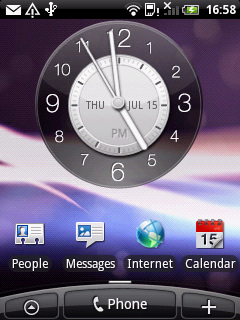
Now back to the other stuff beyond the homescreen and the available Scenes. The changes brought by the Sense UI go deeper than just the homescreen.
For instance, the main menu has the typical grid layout, but you can switch it to a list similar to in TouchFLO in HTC WinMo phones. With it, you can use an alphabet scroll, which makes locating apps faster.

The widget section has been revamped since the HTC Tattoo and now both types of widgets (custom HTC and stock Android) are placed on one page. There are so many of them that you may find the seven homescreen panes insufficient.

When you select a widget you are prompted to choose between several versions – most widgets have at least two styles. The different versions typically offer at least two sizes of the widget and a different look (There are twelve different clocks. That's right, twelve!).

And some widget styles even offer different functionality. Take the Twitter widget for instance - one version will show updates for the people you follow, while the other version only lets you tweet from the homescreen. There's nothing stopping you from using both of course.

The HTC widgets offer a better level of interaction than the stock widgets – there's a Favorites widget that keeps a list of your favorite contacts you can scroll through, meaning there’s no need to dip into the contacts list.
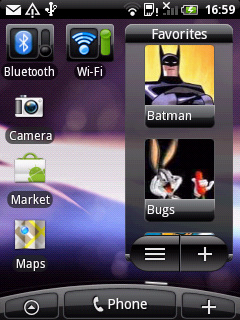
You can pinch to “zoom out” on any of the homescreen panes but tapping on a screen will do the trick too.
The Android 2.1 in the Wildfire packs the app sharing application for posting your impressions on mobile applications via Twitter, SMS or email. It’s very simple but helps you share or receive app impressions from various social services.
Leap View was available back on the HTC Desire – it’s nice to have it in the budget package too. However, one thing the Wildfire obviously lacks is Live Wallpapers. The weaker CPU and the QVGA screen just can’t handle them.
Well, that’s about the part of the Sense UI that’s closest to the surface. There’s more to it but we’ll discuss those bits and pieces throughout the review.
The HTC Wildfire UI is fast enough, the only place to notice lags is in widgets that need internet connection to refresh content.
The trackpad is an auxiliary navigation tool here – given the responsive capacitive touchscreen. You can swipe, scroll and precisely select elements with the trackpad but we were barely using it except in the camera app. It serves as the shutter key there but it’s far from essential, as the touch focus works well.
Two more things - most apps won't run without a microSD card inserted and screen vibration feedback works on the virtual QWERTY keyboard but not elsewhere throughout the homescreen.
Socialized phonebook
HTC Wildfire features the same powerful phonebook we first saw on the Hero. It resembles the one from the HTC TouchFLO but considerably extends its functionality.
Selecting a contact displays the basic details: name and photo, numbers, emails and such. What you'd notice though is that there are another five tabs at the bottom and you're just viewing the first of them.
The next tab holds the messages received from the contact – it would have been a lot more useful if it held the entire conversation, but for that you’d have to go to the Messages app.
The third tab holds a list of emails you've exchanged with the contact. The next two tabs are quite interesting and can turn the Wildfire (or in fact any phone running the Sense UI) into a powerful social networking tool.
The first holds Facebook contact updates, and the other - called "Albums" - pulls the albums that contacts have created on Flickr and Facebook.
The last tab shows the call history for the contact.
The entire People app (the phonebook) is tabbed too and with more tabs than the stock Android. You have all contacts, groups (including favorite contacts there), as well as a call log and "Online directories". The latter holds information for all your buddies’ online profiles.
With Android 2.1, the HTC Wildfire packs the new Quick contacts feature. It lets you use the contact photo in the phonebook and call, text, or email the person with a single click.
The contact editing screen looks exactly as in the HTC Desire. There's no plus key to add a new detail of a certain type, just a delete detail key. This saves some space (one line per each category) but you have to scroll down to the bottom every time you want to add a new detail.
There is a lot of information you can store per contact as usual, and searching the phonebook is very easy - just press the search button.
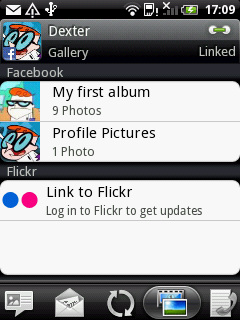
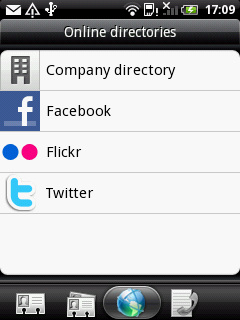
Telephony
Voice quality in calls is good and the volume levels are excellent. We experienced no reception issues with the HTC Wildfire.
The dialer features a keypad, a shortcut to the call log and a list of contacts beneath (you can hide the keypad). Smart Dialing is also enabled.
Thanks to the built-in accelerometer, the HTC Wildfire has turn-to-mute enabled. You can mute the ringer by simply turning the phone face down on the table. There’s an extra feature too – the ringing volume will go down as soon as you lift the handset up.
Telephony
Voice quality in calls is good and the volume levels are excellent. We experienced no reception issues with the HTC Wildfire.
The dialer features a keypad, a shortcut to the call log and a list of contacts beneath (you can hide the keypad). Smart Dialing is also enabled.
Thanks to the built-in accelerometer, the HTC Wildfire has turn-to-mute enabled. You can mute the ringer by simply turning the phone face down on the table. There’s an extra feature too – the ringing volume will go down as soon as you lift the handset up.
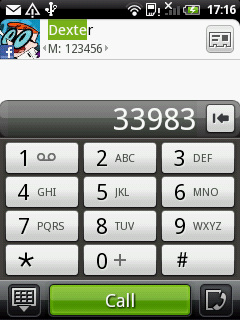
The HTC Wildfire doesn't have voice dialing but what at least some users are more likely to miss is video calling.
We conducted our traditional loudspeaker test and here is how the Wildfire stacks among some other handsets.
Final words
You can't help we guess, but love the sound of it. Wildfire is a strong and beautiful name. The thing is it raises no less expectation than names like Legend or Hero. But we're talking entirely different leagues here. So a simple Desire mini would've told the whole story - and caused no confusion.
Or maybe it's us making it look too complicated when it isn't. There is no doubt the HTC Wildfire is aiming lower and it may as well be competitive enough. It's nearly an HTC Desire save for the screen and processing power.
They didn't even try to be creative. HTC just went on to repackage an existing product for a different target market. You can be sure the HTC Wildfire wants to play by the book and avoid complications. It comes to inherit the Magic and the Tattoo and keep the likes of Samsung Galaxy 3 at a safe distance. It can't be too hard now, can it?
Sony Ericsson already did it with the XPERIA X10 mini. This one is in the same price bracket but still waiting for its Eclair upgrade. What makes it unique is the level of miniaturization - the X10 mini is unmatched in the ultra compact class. It's worth noting too that a QVGA screen makes a lot more sense in a package so small.
The Samsung I5800 Galaxy 3 is another mid-range droid, which isn't ashamed to be seen in QVGA. It's Wide QVGA to be precise but not that big of a difference. Powered by Eclair, the Galaxy 3 is about to start shipping. Native DivX/XviD support is one thing you can sure expect in a Samsung droid. The Galaxy 3 will cost some 300 euro at launch - that's a bit more than the Wildfire.
If you are running a tight budget, a few older Droids might fit the bill. The Samsung Galaxy Spica and the HTC Tattoo are upgradable to Android v2.1 Eclair, while the LG Optimus still runs on the 1.6 Donut.
Over at the Symbian camp, the Sony Ericsson Vivaz will charge the same as the Wildfire but bring better specs, higher-res (though resistive) touchscreen and an excellent camera with 720p video. If you care about imaging, you should definitely check this one out.
Of course, the Wildfire is trying to come across as the budget package. But we do need to define budget here. The simple truth is an HTC phone will never beat the price of a Nokia 5800 XpressMusic. On a second thought, the Wildfire is not trying perhaps to match the record of this absolute best-seller.
The way we see it, Wildfire's fits perfectly in HTC’s Android lineup. It’s not the cheapest Droid out there and it has its compromises but it seems as the cheapest and fastest route to Android 2.1. We don't think any of the Hero, Tattoo or Magic users will see it as a viable upgrade though. For us, the HTC Wildfire is more like the first-timers' Android smartphone.